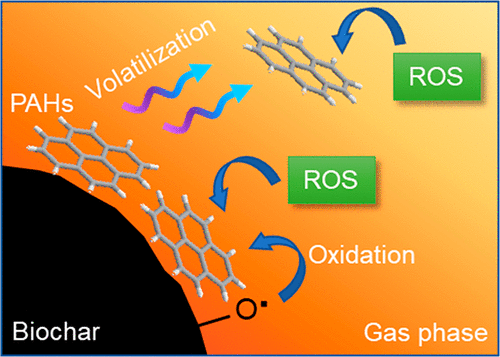当前位置:
X-MOL 学术
›
Environ. Sci. Technol. Lett.
›
论文详情
Our official English website, www.x-mol.net, welcomes your
feedback! (Note: you will need to create a separate account there.)
Abatement of Polycyclic Aromatic Hydrocarbon Residues in Biochars by Thermal Oxidation
Environmental Science & Technology Letters ( IF 8.9 ) Pub Date : 2021-04-22 , DOI: 10.1021/acs.estlett.1c00167 Yi Yang 1, 2 , Jian Wang 3 , Zhengyang Wang 2 , Yanzheng Gao 3 , Joseph J. Pignatello 2
Environmental Science & Technology Letters ( IF 8.9 ) Pub Date : 2021-04-22 , DOI: 10.1021/acs.estlett.1c00167 Yi Yang 1, 2 , Jian Wang 3 , Zhengyang Wang 2 , Yanzheng Gao 3 , Joseph J. Pignatello 2
Affiliation

|
Biochars often contain residues of polycyclic aromatic hydrocarbons (PAHs) that can pose risks to exposed organisms and ultimately to human health. This study shows that thermal oxidation of an anoxically produced (500 °C) softwood biochar using brief post-pyrolysis thermal oxidation in air caused a substantial decline in solvent-extractable PAHs (up to 85% of Tot-PAH) and a sharp decrease (up to 82%) in the EPA Relative Potency Factor. Optimum conditions were 400 °C for 20 min. An alternative approach of including 1% O2 in the nitrogen flow stream during pyrolysis was less effective. PAH loss is attributed to combustion processes as opposed to outgassing. Oxidation of PAHs occurs in the gas and adsorbed phases and is promoted by pore reaming of biochar micropores and mesopores during thermal oxidation, which facilitates diffusive exchange of O2, reactive oxygen species, and PAH molecules. Oxidation also may be promoted by self-heating of the biochar body, which increases the local temperature. The results indicate that a short post-pyrolysis thermal oxidation step can reduce the risks associated with PAH residues in biochar.
中文翻译:

热氧化去除生物炭中多环芳烃残留
生物炭通常含有多环芳烃 (PAH) 的残留物,可能对暴露的生物体并最终对人类健康构成风险。该研究表明,在空气中使用短暂的热解后热氧化对缺氧生产 (500 °C) 软木生物炭进行热氧化会导致可溶剂提取的多环芳烃(高达 Tot-PAH 的 85%)显着下降,并急剧下降高达 82%)在 EPA 相对效力因子中。最佳条件是 400 °C 20 分钟。包含 1% O 2的替代方法在热解过程中的氮气流中效果较差。PAH 损失归因于燃烧过程而不是除气。PAH 的氧化发生在气相和吸附相中,并且在热氧化过程中通过生物炭微孔和中孔的扩孔促进 O 2、活性氧和 PAH 分子的扩散交换。生物炭体的自热也可能促进氧化,这会增加局部温度。结果表明,短暂的热解后热氧化步骤可以降低与生物炭中 PAH 残留相关的风险。
更新日期:2021-06-08
中文翻译:

热氧化去除生物炭中多环芳烃残留
生物炭通常含有多环芳烃 (PAH) 的残留物,可能对暴露的生物体并最终对人类健康构成风险。该研究表明,在空气中使用短暂的热解后热氧化对缺氧生产 (500 °C) 软木生物炭进行热氧化会导致可溶剂提取的多环芳烃(高达 Tot-PAH 的 85%)显着下降,并急剧下降高达 82%)在 EPA 相对效力因子中。最佳条件是 400 °C 20 分钟。包含 1% O 2的替代方法在热解过程中的氮气流中效果较差。PAH 损失归因于燃烧过程而不是除气。PAH 的氧化发生在气相和吸附相中,并且在热氧化过程中通过生物炭微孔和中孔的扩孔促进 O 2、活性氧和 PAH 分子的扩散交换。生物炭体的自热也可能促进氧化,这会增加局部温度。结果表明,短暂的热解后热氧化步骤可以降低与生物炭中 PAH 残留相关的风险。











































 京公网安备 11010802027423号
京公网安备 11010802027423号